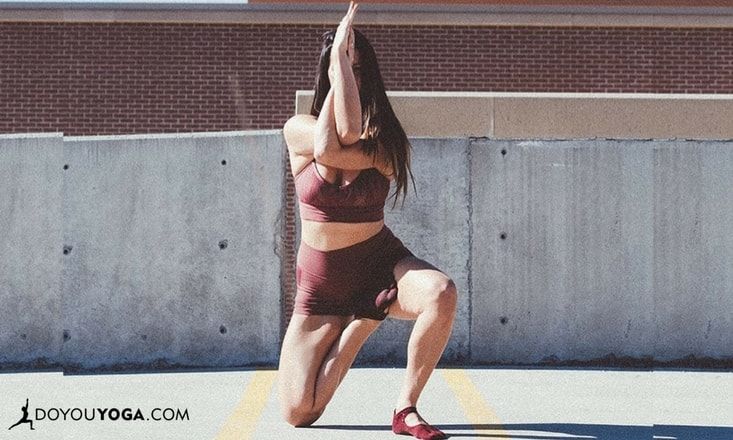Horse Face Pose, or Vatayanasana, is a balancing posture that requires hip and arm flexibility, as well as healthy knees and ankles. The posture is named for its resemblance to a horse’s face, with the balancing knee acting as the nose and the torso, arms and head representing the upper half of the face.
It builds from the characteristics of other poses, including the twist of Garudasana or Eagle arms and the foot to heel connection of Padmasana (Lotus pose) to form a unique blend of twist, balance, and fold to challenge the body and mind.
Benefits of Horse Face Pose
Horse Face Pose promotes good circulation throughout the body, and the intertwined arms help to create flexibility in the upper body. The pose also helps strengthen the bones in the lower body, and alleviates minor asymmetries, particularly the legs and hips.
Mentally, the pose promotes focus to maintain balance. The difficulty of finding this mental balance, combined with the physically challenging aspects of the pose (such as balancing on the knee), requires finding a sense of calm when situations become challenging.
To explore Horse Face Pose safely, your body needs to be warmed up, particularly the ankles, hips and shoulders. Once warmed up, build up to the pose by exploring these postures to prepare the body and mind for your best version of Horse Face Pose.
Half Lotus
Ardha Padmasana is a great pose to explore your hip flexibility and get used to placing the sole of the foot on the hip.
This movement is the seated version of the legs in Horse Face Pose, so take the time to get used to it in a safe, seated pose and allow the hips to open.
Eagle Arms
Full Garudasana, or Eagle pose requires you to balance and twist the top leg over the bottom leg while bending the elbows and intertwining the arms to stretch the arms. Try out the full expression of Eagle pose to challenge your balance, stretch the hips and get used to the way Eagle arms feels to prepare for Horse Face Pose.
Tree Pose with Lotus Leg
Vrkasana or Tree pose is a classic balancing posture that will help you build a calm focus while strengthening the legs. Once you are comfortable in Tree pose, place the leg into a Half Lotus to stretch the hip and explore the feeling of standing.
This is essentially a standing version of Horse Face Pose in the lower legs.
Hero Pose
Virasana or Hero pose stretches the muscles in the legs, particularly the ankles, to prepare for Horse Face Pose. Because Horse Face Pose consists of both plantar (moving away from the body) and dorsal (moving toward the body) flexion from the ankle, Hero pose is a good way to warm up the ankles to prepare for Horse Face Pose.
Hip & Ankle Circles on the Back
Horse Face Pose requires the hips to be warmed up, with the hip of the bent knee able to externally rotate. Explore the way this motion feels while lying on your back. Guide the knee to the chest and begin to make gentle hip circles in both directions. Then circle the ankle, first in one motion and then to the opposite. Repeat on both sides to keep the body balanced.
Full Expression
When your body is warm and open, go ahead and try Horse Face Pose. From kneeling position, bring one leg into Half Lotus and then twist the upper body into an expression of Eagle arms.
Tips & Modifications
Build up with a Blanket
Horse Face Pose puts pressure on the balancing knee, so it’s important to give yourself and your knee the support and comfort necessary to build up to the full expression of the pose.
Grab a blanket and fold it to a thickness that feels right to you. Ideally, you want it to feel stable but not painful on the knee. As you become comfortable in the pose, allow the blanket to unfold and become less thick. This will allow you to support your knee and build up safely and comfortably.
Balance with a Wall
Horse Face Pose challenges your balance, and using a supportive structure like a wall is a great way to support yourself and explore the pose without falling.
Getting into Horse Face Pose may feel awkward. It falls in between a standing and sitting posture, and is essentially a balancing posture on the knee. There are multiple ways to enter the pose, including from a standing or seated position, from all fours, and from a lunge. Find which entry works for you.
It is important to remember that yoga is about practice, not being perfect. Give yourself time and support to explore Horse Face Pose, and see what postures and tips work for you and your body.
Image credit: Alissa










